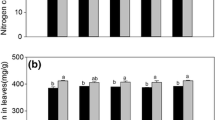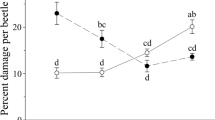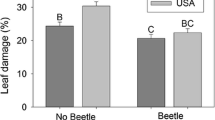Abstract
Effects of herbivory on competition between invasive and native plants have seldom been examined from an above-belowground integrated perspective. We examined the interactions between a monophagous beetle, Agasicles hygrophila, or an oligophagous beetle, Cassida piperata, and a root-knot nematode on the intensity of intra- and interspecific interactions between the invasive Alternanthera philoxeroides and its native congener, Alternanthera sessilis. Plant-plant competition was assessed using the relative neighbour effect (RNE) index. Competitive effects (positive RNE indexes) from conspecifics for A. philoxeroides were detected under herbivory by A. hygrophila alone. The ramet number, stolon length, and/or the biomass of A. philoxeroides were reduced compared to plants without herbivory. The interactions between the two plants without herbivory were facilitative (negative RNE indexes), and the facilitative effect became stronger such that A. philoxeroides produced more biomass under combinative herbivory by C. piperata and the nematode. However, significant competitive effects from conspecifics were detected for A. sessilis under all the AG-BG herbivory treatments, while no apparent competitive or facilitative effects from A. philoxeroides were detected for A. sessilis under all the AG-BG herbivory treatments. These results suggest that intra- or interspecific competition of invasive and native plants can be greatly affected by AG-BG herbivory, and thus interactive effects of AG-BG herbivory and plant competition may influence invasive process of alien plants in the field.




Similar content being viewed by others
Data availability
Data are available in the electronic appendices and are also available from the corresponding author on reasonable request.
References
Adler PB, Smull D, Beard KH et al (2018) Competition and coexistence in plant communities: intraspecific competition is stronger than interspecific competition. Ecol Lett 21:1319–1329. https://doi.org/10.1111/ele.13098
Agrawal AA, Fishbein M (2006) Plant defense syndrom. Ecology 87:132–149. https://doi.org/10.1890/0012-9658(2006)87[132:PDS]2.0.CO;2
Arsenault R, Owen-Smith N (2002) Facilitation versus competition in grazing herbivore assemblages. Oikos 97:313–318. https://doi.org/10.1034/j.1600-0706.2002.970301.x
Backmann P, Grimm V, Jetschke G et al (2019) Delayed chemical defense: timely expulsion of herbivores can reduce competition with neighboring plants. Am Nat 193:125–139. https://doi.org/10.1086/700577
Beaton LL, Van Zandt PA, Esselman EJ et al (2011) Comparison of the herbivore defense and competitive ability of ancestral and modern genotypes of an invasive plant, Lespedeza cuneata. Oikos 120:1413–1419. https://doi.org/10.1111/j.1600-0706.2011.18893.x
Bezemer TM, van Dam NM (2005) Linking aboveground and belowground interactions via induced plant defenses. Trends Ecol Evol 20:617–624. https://doi.org/10.1016/j.tree.2005.08.006
Blossey B, Notzold R (1995) Evolution of increased competitive ability in invasive nonindigenous plants: a hypothesis. J Ecol 83:887–889. https://doi.org/10.2307/2261425
Callaway RM, Walker LR (1997) Competition and facilitation: a synthetic approach to interactions in plant communities. Ecology 78:1958–1965. https://doi.org/10.1890/0012-9658(1997)078[1958:CAFASA]2.0.CO;2
Center TD (2005) Herbivory alters competitive interactions between two invasive aquatic plants. Biol Control 33:173–185. https://doi.org/10.1016/j.biocontrol.2005.02.005
Cornelissen JH, Song YB, Yu FH et al (2014) Plant traits and ecosystem effects of clonality: a new research agenda. Ann Bot 114:369–376. https://doi.org/10.1093/aob/mcu113
Davidson AM, Jennions M, Nicotra AB (2011) Do invasive species show higher phenotypic plasticity than native species and if so, is it adaptive? A meta-analysis. Ecol Lett 14:419–431. https://doi.org/10.1111/j.1461-0248.2011.01596.x
Drenovsky RE, Grewell BJ, D’Antonio CM et al (2012) A functional trait perspective on plant invasion. Ann Bot 110:141–153. https://doi.org/10.1093/aob/mcs100
Ehrenfeld JG (2010) Ecosystem consequences of biological invasions. Annu Rev Ecol Evol S 41:59–80. https://doi.org/10.1146/annurev-ecolsys-102209-144650
Geng YP, Pan XY, Xu CY et al (2006) Phenotypic plasticity of invasive Alternanthera philoxeroides in relation to different water availability, compared to its native congener. Acta Oecol 30:380–385. https://doi.org/10.1016/j.actao.2006.07.002
Gruntman M, Pehl AK, Joshi S et al (2014) Competitive dominance of the invasive plant Impatiens glandulifera: using competitive effect and response with a vigorous neighbour. Biol Invasions 16:141–151. https://doi.org/10.1007/s10530-013-0509-9
Hambäck PA, Beckerman AP (2003) Herbivory and plant resource competition: a review of two interacting interactions. Oikos 101:26–37. https://doi.org/10.1034/j.1600-0706.2003.12568.x
He MY, Ding JQ, Lu XM (2014) Increased compensatory ability of an invasive plant to above- and below-ground enemies in monocultures. Plant Ecol 215:253–260. https://doi.org/10.1007/s11258-013-0294-7
Huang W, Carrillo J, Ding JQ et al (2012a) Interactive effects of herbivory and competition intensity determine invasive plant performance. Oecologia 170:373–382. https://doi.org/10.1007/s00442-012-2328-6
Huang W, Carrillo J, Ding JQ et al (2012b) Invader partitions ecological and evolutionary responses to above- and belowground herbivory. Ecology 93:2343–2352. https://doi.org/10.1890/11-1964.1
Ibanez S, Bison M, Lavorel S et al (2013) Herbivore species identity mediates interspecific competition between plants. Community Ecol 14:41–47. https://doi.org/10.1556/ComEc.14.2013.1.5
Jakobs G, Weber E, Edwards PJ (2004) Introduced plants of the invasive Solidago gigantea (Asteraceae) are larger and grow denser than conspecifics in the native range. Divers Distrib 10:11–19. https://doi.org/10.1111/j.1472-4642.2004.00052.x
Jing J, Raaijmakers C, Kostenko O et al (2015) Interactive effects of above- and belowground herbivory and plant competition on plant growth and defence. Basic Appl Ecol 16:500–509. https://doi.org/10.1016/j.baae.2015.04.009
Joshi J, Vrieling K (2005) The enemy release and EICA hypothesis revisited: incorporating the fundamental difference between specialist and generalist herbivores. Ecol Lett 8:704–714. https://doi.org/10.1111/j.1461-0248.2005.00769.x
Keane RM, Crawley MJ (2002) Exotic plant invasions and the enemy release hypothesis. Trends Ecol Evol 17:164–170. https://doi.org/10.1016/S0169-5347(02)02499-0
Kim TN, Underwood N, Inouye BD (2013) Insect herbivores change the outcome of plant competition through both inter- and intraspecific processes. Ecology 94:1753–1763. https://doi.org/10.1890/12-1261.1
Larson DL, Larson JL (2010) Control of one invasive plant species allows exotic grasses to become dominant in northern Great Plains grasslands. Biol Conserv 143:1901–1910. https://doi.org/10.1016/j.biocon.2010.04.045
Li XQ, Gao X, Siemann E et al (2020) Effects of above- and belowground herbivory of specialists and generalists on the growth and defensive chemicals of introduced and native Chinese tallow seedlings. Plant Soil 455:65–78. https://doi.org/10.1007/s11104-020-04666-2
Liu J, Dong M, Miao SL et al (2006) Invasive alien plants in China: role of clonality and geographical origin. Biol Invasions 8:1461–1470. https://doi.org/10.1007/s10530-005-5838-x
Liu WZ (2000) Plant pathogen nematology. China Agricultural Press, Beijing, China
Louda SM, Keeler KH, Holt RD (1990) Herbivore influences on plant performance and competitive interactions. In: Grace JB, Tilman D (eds) Perspectives on plant competition. Academic Press, New York, USA, pp 413–444
Lu XM, Ding JQ (2010) Flooding compromises compensatory capacity of an invasive plant: implications for biological control. Biol Invasions 12:179–189. https://doi.org/10.1007/s10530-009-9441-4
Lu XM, Ding JQ (2012) History of exposure to herbivores increases the compensatory ability of an invasive plant. Biol Invasions 14:649–658. https://doi.org/10.1007/s10530-011-0106-8
Lu XM, Shao X, Ding JQ (2014) No impact of a native beetle on exotic plant performance and competitive ability due to plant compensation. Plant Ecol 215:275–284. https://doi.org/10.1007/s11258-014-0296-0
Müller-Schärer H, Schaffner U, Steinger T (2004) Evolution in invasive plants: implications for biological control. Trends Ecol Evol 19:417–422. https://doi.org/10.1016/j.tree.2004.05.010
Mangla S, Sheley RL, James JJ et al (2011) Intra and interspecific competition among invasive and native species during early stages of plant growth. Plant Ecol 212:531–542. https://doi.org/10.1007/s11258-011-9909-z
Markham JH, Chanway CP (1996) Measuring plant neighbour effects. Funct Ecol 10:548–549
Meyer G, Clare R, Weber E (2005) An experimental test of the evolution of increased competitive ability hypothesis in goldenrod, Solidago gigantea. Oecologia 144:299–307. https://doi.org/10.1007/s00442-005-0046-z
Oborny B, Kun Á (2002) Fragmentation of clones: how does it influence dispersal and competitive ability? In: Stuefer JF, Erschbamer B, Huber H, Suzuki J (eds) Ecology and evolutionary biology of clonal plants. Springer, Dordrecht, pp 97–124
Ohgushi T, Wurst S, Johnson SN (2018) Current knowledge and future challenges of aboveground and belowground community ecology. Aboveground belowground community ecology. Springer, NewYork, pp 345–361
Pan JJ, Price JS (2002) Fitness and evolution in clonal plants: the impact of clonal growth. In: Stuefer JF, Erschbamer B, Huber H, Suzuki J (eds) Ecology and evolutionary biology of clonal plants. Springer, Dordrecht., pp 361–378
Pan XY, Geng YP, Alejandro S et al (2007) Invasive Alternanthera philoxeroides: biology, ecology and management. J Syst Evol 45:884–900. https://doi.org/10.1360/aps06134
Parker JD, Torchin ME, Hufbauer RA et al (2013) Do invasive species perform better in their new ranges? Ecology 94:985–994. https://doi.org/10.1890/12-1810.1
Poorter H, Nagel O (2000) The role of biomass allocation in the growth response of plants to different levels of light, CO2, nutrients and water: a quantitative review. Funct Plant Biol 27:1191–1191. https://doi.org/10.1071/PP99173_CO
Rand TA (2004) Competition, facilitation, and compensation for insect herbivory in an annual salt marsh forb. Ecology 85:2046–2052. https://doi.org/10.1890/03-3087
Ren GQ, Li Q, Li Y et al (2019) The enhancement of root biomass increases the competitiveness of an invasive plant against a co-occurring native plant under elevated nitrogen deposition. Flora 261:151486. https://doi.org/10.1016/j.flora.2019.151486
Sheppard CS, Burns BR (2014) Effects of interspecific alien versus intraspecific native competition on growth of native woody plants. Plant Ecol 215:1527–1538. https://doi.org/10.1007/s11258-014-0411-2
Silveira MJ, Thiébaut G (2020) Effect of density and neighbours on interactions between invasive plants of similar growth form. Aquat Ecol 54:463–474. https://doi.org/10.1007/s10452-020-09753-1
Simberloff D, Martin JL, Genovesi P et al (2013) Impacts of biological invasions: what’s what and the way forward. Trends Ecol Evol 28:58–66. https://doi.org/10.1016/j.tree.2012.07.013
Sun Y, Ding JQ, Frye MJ (2010) Effects of resource availability on tolerance of herbivory in the invasive Alternanthera philoxeroides and the native Alternanthera sessilis. Weed Res 50:527–536. https://doi.org/10.1111/j.1365-3180.2010.00822.x
Wan JZ, Wang CJ, Yu FH (2019) Large-scale environmental niche variation between clonal and non-clonal plant species: Roles of clonal growth organs and ecoregions. Sci Total Environ 652:1071–1076. https://doi.org/10.1016/j.scitotenv.2018.10.280
Wang T, Hu JT, Miao LL et al (2016) The invasive stoloniferous clonal plant Alternanthera philoxeroides outperforms its co-occurring non-invasive functional counterparts in heterogeneous soil environments-invasion implications. Sci Rep 6:38036. https://doi.org/10.1038/srep38036
Wang T, Hu JT, Wang RQ et al (2018) Tolerance and resistance facilitate the invasion success of Alternanthera philoxeroides in disturbed habitats: A reconsideration of the disturbance hypothesis in the light of phenotypic variation. Environ Exp Bot 153:135–142. https://doi.org/10.1016/j.envexpbot.2018.05.011
Wang Y, Xiong YT, Wang Y et al (2021) Long period exposure to serious cadmium pollution benefits an invasive plant (Alternanthera philoxeroides) competing with its native congener (Alternanthera sessilis). Sci Total Environ 786:147456. https://doi.org/10.1016/j.scitotenv.2021.147456
Wang YJ, Müller-Schärer H, van Kleunen M et al (2017) Invasive alien plants benefit more from clonal integration in heterogeneous environments than natives. New Phytol 216:1072–1078. https://doi.org/10.1111/nph.14820
Wardle DA, Bardgett RD, Klironomos JN et al (2004) Ecological linkages between aboveground and belowground biota. Science 304:1629–1633. https://doi.org/10.1126/science.1094875
Wei H, He MY, Lu XM et al (2016) Differences in interactions of aboveground and belowground herbivores on the invasive plant Alternanthera philoxeroides and native host A. sessilis. Biol Invasions 18:3437–3447. https://doi.org/10.1007/s10530-016-1234-y
You WH, Han CM, Fang LX et al (2016) Propagule pressure, habitat conditions and clonal integration influence the establishment and growth of an invasive clonal plant Alternanthera Philoxeroides. Front Plant Sci 7:568. https://doi.org/10.3389/fpls.2016.00568
Yu HH, Fan SF (2018) Differences in physiological traits and resistances of Alternanthera philoxeroides after herbivory by generalists and specialists. Aquat Ecol 52:323–332. https://doi.org/10.1007/s10452-018-9666-3
Yu HW, Shen N, Guan X et al (2019) Influence of soil nutrient heterogeneity and competition on sprouting and ramets growth of Alternanthera philoxeroides. CLEAN-Soil, Air, Water 47:1800182. https://doi.org/10.1002/clen.201800182
Zhang JL, Huang W, Ding JQ (2021) Phenotypic plasticity in resource allocation to sexual trait of alligatorweed in wetland and terrestrial habitats. Sci Total Environ 757:143819. https://doi.org/10.1016/j.scitotenv.2020.143819
Zheng YL, Feng YL, Valiente-Banuet A et al (2015) Are invasive plants more competitive than native conspecifics? Patterns vary with competitors. Sci Rep 5:15622. https://doi.org/10.1038/srep15622
Acknowledgements
We would like to thank Yao Xiang, Zhongcai Ma, and Shunliang Feng for insect collection and experimental assistance. We especially thank two anonymous reviewers for their valuable comments on earlier versions of this paper. We would also like to thank Van Driesche Scientific Editing for editing of the manuscript.
Funding
This study was funded by the National Natural Science Foundation of China (31800423), the Natural Science Foundation of Guangxi Province (2018GXNSFBA281172), and the Science Development Foundation of Guangxi Academy of Agricultural Sciences (2021YT119).
Author information
Authors and Affiliations
Contributions
SS conceptualization, data manipulation, formal analysis, methodology, writing-original draft. WG data manipulation, software, investigation, writing-review and editing. XL project administration, funding acquisition, writing-review and editing, supervision.
Corresponding author
Ethics declarations
Conflict of interest
The authors declare that they have no conflict of interest.
Additional information
Publisher's Note
Springer Nature remains neutral with regard to jurisdictional claims in published maps and institutional affiliations.
Rights and permissions
About this article
Cite this article
Shen, S., Guo, W. & Li, X. Above- and belowground herbivory alters the outcome of intra- and interspecific competition between invasive and native Alternanthera species. Biol Invasions 24, 801–813 (2022). https://doi.org/10.1007/s10530-021-02694-2
Received:
Accepted:
Published:
Issue Date:
DOI: https://doi.org/10.1007/s10530-021-02694-2




